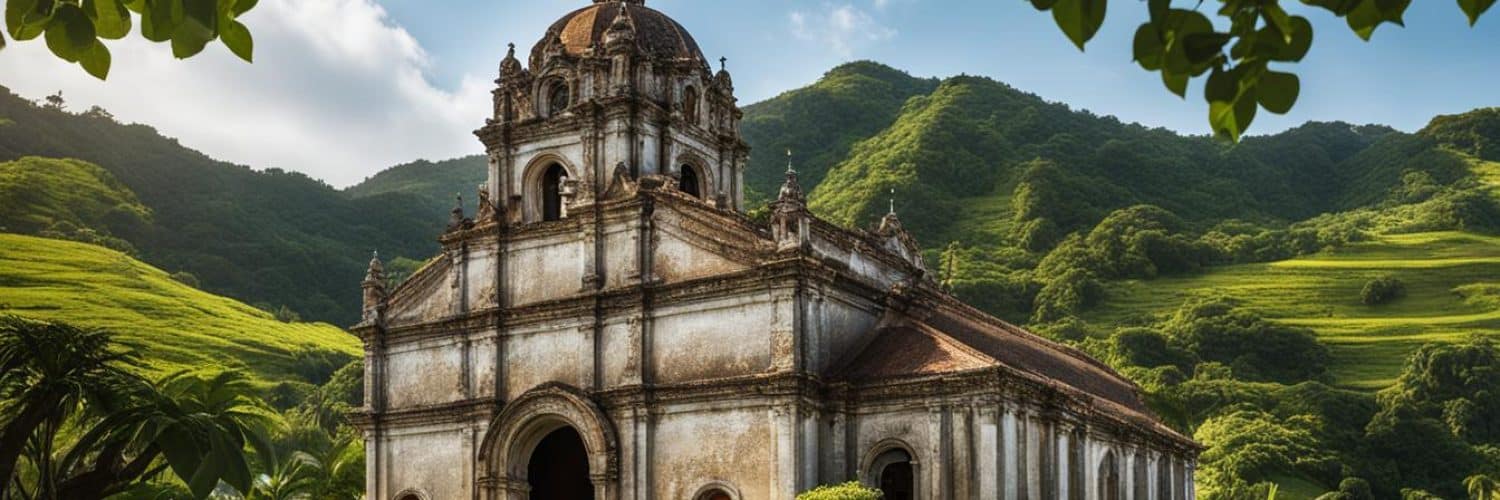Discover the cultural heritage of Bohol, Philippines with a visit to Dimiao Church. Situated in the charming town of Dimiao, this historical landmark takes you on a journey back to the Spanish colonial era, showcasing architectural wonders and religious sites that have stood the test of time. Whether you’re a history enthusiast or simply looking for must-visit destinations in Bohol, Dimiao Church is a top sight that should not be missed.
Step inside Dimiao Church and be captivated by its rich history and cultural significance. With its impressive architecture and intricate details, this historical gem offers a glimpse into the region’s past and acts as a testament to the enduring cultural heritage of the Philippines. From the stunning facade to the beautifully crafted interiors, every corner of Dimiao Church is a feast for the eyes.
Key Takeaways:
- Dimiao Church is a historical landmark and cultural treasure in Bohol, Philippines.
- It showcases architectural wonders and religious sites from the Spanish colonial era.
- Dimiao Church offers a glimpse into the cultural heritage of Bohol.
- It is a must-visit destination for history enthusiasts and those seeking top tourist spots.
- The church’s impressive architecture and rich history make it a popular attraction in Bohol.
History of Dimiao Church
Dimiao Church, also known as San Nicolas de Tolentino Church, has a deep history that dates back to the Spanish era. Established in 1750 by the Jesuits, it became the sixth parish in Bohol during that time. Although the exact founding date remains uncertain, the church has witnessed numerous renovations and restoration works over the years, continuously preserving its architectural and historical significance.
Declared a National Cultural Treasure by the National Museum in 2011, Dimiao Church stands as a testament to the region’s rich cultural heritage. The church complex, which includes the convent, sacristy, kitchen, and Ermita ruins, holds immense historical importance and serves as a tangible link to Bohol’s past.
Throughout its existence, Dimiao Church has played a significant role in the spiritual and cultural life of the community, attracting both locals and tourists alike. Its historical significance and captivating architecture make it a must-visit destination for those interested in experiencing the grandeur of the Spanish colonial era in the Philippines.
Timeline of Dimiao Church’s History
| Year | Milestone |
|---|---|
| 1750 | Established by the Jesuits, becoming the sixth parish in Bohol |
| 19th century | Underwent renovations and restoration works |
| 2011 | Declared a National Cultural Treasure by the National Museum |
Architecture of Dimiao Church
Dimiao Church showcases a captivating architectural style that seamlessly blends Baroque characteristics with Muslim influences. The facade of the church is adorned with elaborate decorative molding, comprising a base, two levels, and an uppermost section featuring a gable flanked by octagonal belfries. The entrance door, arched and surrounded by blind arch windows, serves as an impressive focal point. Engaged Corinthian columns, pilasters, and a coat of arms further embellish the facade, exuding grandeur and elegance.
The interior of Dimiao Church is equally remarkable. A beautifully crafted wooden altar takes center stage, drawing the gaze with its intricate carving and attention to detail. The pulpit, another notable feature, showcases the church’s commitment to artistry and craftsmanship. Additionally, visitors can admire a 19th-century pipe organ, a testament to both the church’s historical relevance and its dedication to music and worship.
These architectural elements collectively create a serene and awe-inspiring atmosphere within Dimiao Church. The marriage of Baroque characteristics and Muslim influences results in a unique visual experience, showcasing the diverse cultural influences that have shaped the church’s design. Whether appreciating the elaborate facade or admiring the intricate interior craftsmanship, visitors are sure to be captivated by the architectural wonders of Dimiao Church.
Cultural and Heritage Significance of Dimiao Church
Dimiao Church, along with its surrounding complex, holds immense cultural and heritage significance. Recognized as a National Cultural Treasure, it represents the rich history and traditions of the Philippines. The church is dedicated to St. Nicholas of Tolentino, a revered saint whose feast day is celebrated on September 10 every year. The festivities during this time showcase the deep-rooted cultural heritage of Dimiao and attract both locals and tourists alike.
“Dimiao Church stands as a testament to our cultural heritage, preserving the essence of our past and providing a glimpse into the lives of those who came before us. It serves as a living reminder of our roots and traditions, connecting us to our ancestors and uniting us as a community.”
The local government of Dimiao organizes the Pamakwan Festival every May, a vibrant celebration that highlights the town’s culture and traditions. This festival offers visitors a unique opportunity to immerse themselves in the festive spirit, witness traditional dances and music performances, and savor local delicacies. The Pamakwan Festival serves as a platform to promote and preserve the cultural heritage of Dimiao, reinforcing the town’s commitment to honoring its past.
Dimiao Church, being a National Cultural Treasure and home to various cultural festivities, plays a vital role in safeguarding the intangible and tangible heritage of the Philippines. Its architectural beauty and historical significance make it a must-visit destination for those seeking to explore and appreciate the rich cultural tapestry of Bohol.
Visiting Dimiao Church
Dimiao Church is a welcoming place that is open to the public, allowing visitors to immerse themselves in its historical and cultural treasures. As you step inside, you’ll find a serene atmosphere that invites reflection and appreciation for the church’s architectural details.
When visiting Dimiao Church, it’s important to dress modestly and respectfully. This shows reverence for the religious significance of the church and ensures you are honoring its sacred space. Modest attire, such as covering your shoulders and knees, is appreciated.
The church offers regular masses throughout the week, providing visitors with an opportunity to experience the spirituality of this historical setting. Whether you attend a mass or simply explore the church’s interior, you will be able to witness the deep devotion and faith that is ingrained in this place of worship.
To plan your visit, it is recommended to check the church’s official website or contact them directly. This will provide you with the most up-to-date information on mass schedules and any special events that may be taking place. You can ensure that your visit aligns with your desired experience and maximizes your time at Dimiao Church.
As you navigate this extraordinary heritage site, take your time to appreciate the intricate details of the architecture, the skillful craftsmanship of the woodwork, and the centuries-old history that emanates from every corner. Dimiao Church is a testament to the enduring spirit of the Filipino people and their rich cultural heritage.
Immerse yourself in the beauty and spirituality of Dimiao Church, experiencing firsthand the historical significance and cultural richness it offers. Plan your visit, dress respectfully, and be prepared to be captivated by the charm and authenticity of this cherished landmark.
Other Heritage Churches in Bohol
In addition to Dimiao Church, Bohol is home to several other remarkable heritage churches that contribute to the rich cultural heritage of the region. Each church showcases unique architectural styles and holds historical significance. Let’s explore some of these beautiful churches:
Baclayon Church
The Baclayon Church, located in the town of Baclayon, is the oldest church in Bohol. It boasts neoclassical architecture and is recognized as a National Cultural Treasure. The church’s grandeur and historical importance make it a must-visit destination for those interested in the religious and architectural heritage of Bohol.
Loboc Church
The Loboc Church, also known as the San Pedro Apostol Church, features a stunning Baroque architectural style. It is another National Cultural Treasure, attracting visitors with its intricate details and rich history. The church played a significant role in the Spanish colonial era and remains a testament to Bohol’s cultural heritage.
Dauis Church
The Dauis Church, officially called the Church of Our Lady of the Assumption, showcases an exquisite Gothic-inspired design. Situated in the town of Dauis, this church captivates visitors with its elaborate stone carvings and stained glass windows. Its unique architectural style sets it apart from other churches in Bohol.
Tagbilaran Church
Tagbilaran Church, also known as the Cathedral of Saint Joseph the Worker, is located in the city of Tagbilaran. This church combines Baroque and Neoclassical elements, creating a harmonious blend of architectural styles. It stands as a historical landmark and a symbol of faith and devotion in the heart of Bohol.
These heritage churches in Bohol not only symbolize the religious fervor of the people but also showcase the architectural prowess of past generations. Each church tells a unique story and offers visitors an opportunity to immerse themselves in the rich cultural heritage of Bohol.
Restored Churches in Bohol
Bohol, a province in the Philippines, is home to several heritage churches that have undergone restoration projects following damages caused by earthquakes. These restoration efforts have been undertaken to preserve the historical and architectural significance of these churches, ensuring they can be enjoyed by both current visitors and future generations.
One such church that has undergone restoration is Dimiao Church. After the devastating earthquake in 2013, Dimiao Church, along with many other churches in Bohol, was repaired and restored to its former glory. Efforts were made to carefully preserve the unique architectural features and cultural treasures housed within the church.
Restoration projects like these are vital for the preservation of Bohol’s cultural heritage. By safeguarding these cultural and architectural gems, the projects contribute to maintaining the region’s historical identity and attracting tourists interested in experiencing the rich history and heritage of Bohol.
Through the dedication and expertise of restoration teams, these historic churches have been revived and now stand as magnificent testaments to the resilience of the Filipino people and their commitment to preserving their cultural legacy.
| Restored Churches in Bohol | Year of Restoration |
|---|---|
| Dimiao Church | 2013 |
| Baclayon Church | 2017 |
| Loboc Church | 2014 |
| Dauis Church | 2016 |
Unique Features of Bohol Churches
The churches in Bohol exhibit a variety of architectural styles, ranging from Baroque and Neoclassical to Gothic-inspired designs. Each church has its own unique features and historical significance, making them not only religious sites but also important cultural symbols.
These churches boast stunning facades, intricately designed interiors, and preserved heritage features that offer a fascinating glimpse into the region’s history and architectural heritage. Here are some notable examples:
Baclayon Church
The Baclayon Church, the oldest church in Bohol, showcases neoclassical architecture and is a National Cultural Treasure. With its grand facade, detailed stone carvings, and impressive bell tower, Baclayon Church is a testament to the rich history of the region.
Loboc Church
Loboc Church, also known as the San Pedro Apostol Church, features a beautiful Baroque architectural style and is also declared a National Cultural Treasure. Its intricate facade, ornate altar, and exquisite artwork inside make it a must-visit for history and art enthusiasts.
Dauis Church
The Church of Our Lady of the Assumption in Dauis attracts attention with its Gothic-inspired design. The church’s stunning stained glass windows, intricate stone carvings, and old-world charm contribute to its cultural significance and historical allure.
Tagbilaran Church
Tagbilaran Church, also known as the Cathedral of Saint Joseph the Worker, combines elements of Baroque and Neoclassical architecture. Its impressive facade, adorned with intricate details and grand columns, stands as an iconic symbol in Tagbilaran City.
These churches are not only architectural marvels but also serve as historical landmarks and cultural symbols in Bohol. They are a true testament to the region’s rich heritage and are cherished by locals and visitors alike.
Conclusion
Dimiao Church, located in the picturesque town of Dimiao in Bohol, Philippines, stands as a testament to the region’s rich cultural heritage and historical significance. Alongside the other heritage churches in Bohol, it offers visitors a captivating experience, showcasing impressive architectural wonders and providing a window into the past.
With its unique blend of Baroque and Muslim influences, Dimiao Church’s facade is a sight to behold, adorned with decorative molding and intricate details. The church’s interior is equally mesmerizing, boasting a beautifully crafted wooden altar, pulpit, and a magnificent 19th-century pipe organ.
As a must-visit destination, Dimiao Church allows visitors to immerse themselves in the charm and beauty of Bohol, offering a glimpse into the region’s cultural heritage. Whether you are curious about the Spanish colonial era or simply captivated by architectural wonders, these churches, including Dimiao Church, are sure to leave a lasting impression on all who have the opportunity to explore them.
FAQ
What is the historical significance of Dimiao Church?
Dimiao Church, also known as San Nicolas de Tolentino Church, is a historic Roman Catholic Church that dates back to the Spanish colonial era. It was established by the Jesuits in 1750 and is the sixth parish in Bohol. It holds immense historical significance and has undergone several renovations and restoration works over the years.
What architectural style does Dimiao Church exhibit?
Dimiao Church exhibits a captivating architectural style that combines Baroque characteristics with Muslim influences. The facade of the church is adorned with decorative molding and features a base, two levels, and an uppermost section with a gable flanked by octagonal belfries. The interior of the church is home to a beautifully crafted wooden altar, pulpit, and a 19th-century pipe organ.
Why is Dimiao Church considered a National Cultural Treasure?
Dimiao Church was declared a National Cultural Treasure by the National Museum in 2011. It plays a crucial role in preserving the cultural heritage of the Philippines. The church is dedicated to St. Nicholas of Tolentino, and his feast day is celebrated on September 10. The local government of Dimiao holds the Pamakwan Festival every May, which showcases the vibrant culture and traditions of the town.
Can the public visit Dimiao Church?
Yes, Dimiao Church is open to the public, allowing visitors to explore its interior, admire its architectural details, and appreciate the cultural treasures it holds. It is important to dress modestly and respectfully when visiting as a sign of respect for the religious significance of the church. The church also offers regular masses throughout the week, providing visitors with an opportunity to experience the spirituality of this historical setting. It is recommended to check the church’s official website or contact them directly for the most up-to-date mass schedules.
Are there other heritage churches to visit in Bohol?
Yes, Bohol is home to several other remarkable heritage churches. Baclayon Church, the oldest church in Bohol, showcases neoclassical architecture and is a National Cultural Treasure. Loboc Church, known as the San Pedro Apostol Church, features a Baroque architectural style and is also a National Cultural Treasure. Dauis Church, or the Church of Our Lady of the Assumption, boasts an intricate Gothic-inspired design. Tagbilaran Church, also known as the Cathedral of Saint Joseph the Worker, combines Baroque and Neoclassical elements. These churches collectively contribute to the rich cultural heritage of Bohol.
Have the churches in Bohol undergone restoration projects?
Yes, several heritage churches in Bohol, including Dimiao Church, have undergone restoration projects due to damages caused by earthquakes. These restoration efforts aim to preserve the historical and architectural significance of these churches. After the devastating earthquake in 2013, many of these churches were repaired and restored to their former glory. The restoration projects have been successful in ensuring that these cultural treasures continue to be enjoyed by visitors and future generations.
What makes the churches in Bohol unique?
The churches in Bohol exhibit a variety of architectural styles, ranging from Baroque and Neoclassical to Gothic-inspired designs. Each church has its own unique features and historical significance, making them not only religious sites but also important cultural symbols. From stunning facades and intricate interior details to preserved heritage features, the churches in Bohol provide a fascinating glimpse into the region’s history and architectural heritage.


















Add comment